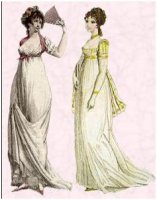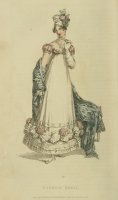More fun with historical research: Ball gowns!
 And here’s where most men will stop reading…
And here’s where most men will stop reading…
As Mr. Bennet himself put it so elegantly when his wife attempted to describe ball gowns to him in the BBC film version of Pride and Prejudice:
“No lace. No lace, Mrs. Bennet, I beg you!”
Chapter three of Pride and Prejudice expresses Mr. Bennet’s disdain for discussions of lace as well, but without the excellent line of dialogue.
I rarely have male critique partners, but when I do they generally balk at descriptions of clothes in historical segments, whereas female critique partners tend to beg for even more description.
 I suspect that most female readers would also enjoy the historical research surrounding 19th century ball gowns as much as I do.
I suspect that most female readers would also enjoy the historical research surrounding 19th century ball gowns as much as I do.
For the early 19th century was a romantic era in fashion. The poetry of Lord Byron was on the lips of well-bred men and women. Empire-waisted gowns necessitated gentle, flowing skirts, with lots of movement. Arms and busts – generally not on display during the day – were de rigeur at balls.
I’ve been to numerous museums displaying these lovely gowns. I’ve also looked through hundreds and hundreds of drawings of gowns at the time, and I find most of them impossibly beautiful, although I might take issue of some of the popular colors at the time – like puce, which I have worked into the 19th century scenes of my manuscript Dark Blue Waves.
 I also remain rather skeptical about the military look that was in vogue for a period of time – gold buttons and gold military braiding – and the exaggerated feathers and turbans that one could often see during the Regency period.
I also remain rather skeptical about the military look that was in vogue for a period of time – gold buttons and gold military braiding – and the exaggerated feathers and turbans that one could often see during the Regency period.
But other than a few fashion mis-steps, I love the gowns of the period, and believe the women looked so beautiful and elegant. It was an absolute pleasure to sift through the lithographs of stunning gowns of 1813, when parts of my story take place. Now, if only I could travel back in time, like the protagonist in my story, and have the opportunity to dress in these beautiful clothes myself, in the hopes that some handsome man “with ten-thousand a year” might ask me to dance.
And you readers? Do you have historical research involved in your stories? Do you enjoy getting lost in these historical details?
If you missed it, I wrote an earlier piece on researching 19th century riding habits.
I really like women wearing gowns like these for paties
– so I would find my tux… “lol”
Wow, Ledrakenoir … a man did make it past the first lines (unlike Mr. Bennet). My sincere thanks! : )
Absolutely love getting lost in research!
It’s fun, isn’t it Claire? Maybe it helps that we both lives in places where you can squint your eyes and ignore the cars and feel as if things haven’t changed much over the past centuries (in a good way, of course…)
Hello, hon! 🙂
Great post! I do the eye-squinting thing too.
As I probably mentioned before, I spent two days researching trebuchets, watching endless YouTube videos of these siege monsters to try and get the sounds right. Recently, I spent the best part of a week procrast… I mean, researching medieval medicine and surgery, I found some amazing free books to download, lots of ancient information.
Researching is almost as much fun as writing. Almost!
Ciao Nicola! Do you know, I didn’t even know what a trebuchet was before I read your chapters. Your procrastina… I mean, research, was put to good use. I really felt I was in the heart of the battle, but from the safetly of my own armchair. : ) I agree that the research is almost as much fun as writing. Well, unless I decide to write a book on astrophysics or international accounting, that is. : )
If fashion goes in cycles – how long will we have to wait for those gowns to come back in? I’d love that. As for research – I managed to waste/use plenty of hours on plant dyes for yarn and the details of knitting stitches for “Hooked”. I think I’ve been researching my coastal novels my entire life (the first one’s set in a lighthouse). My house is filled with coastal books and items.
Do you think they might, Grace? I’d love that, too. I benefitted from all your research on dyes, which I knew nothing about before I read your chapters. Love lighthouses. Look forward to reading your WIP!
Very useful, Kimberly. I am also writing a historical novel bases in New Orleans in the 1830’s. Your research compliments mine. Clothing was so much more important to people back then. There were no off-the-rack dresses back then, everything had to be tailored by hand and fitted to the individual. Thus, one’s clothing was a special thing.
Thanks Chuck! Look forward to hearing more about your project. A story set in 1830 in New Orleans must be fascinating to research. Happy writing (and researching)!
I enjoyed reading this post, Kimberly. I am reading Dostoevsky Crime and Punishment now, so my mind is floating in that century… those dresses are beautiful.
Love Crime an Punishment, and yes, I love to let my imagination roam free when I’m reading about a different time and – even better – an exotic locale, like St Petersburg in the mid-nineteenth century. Enjoy the armchair time travel. : )